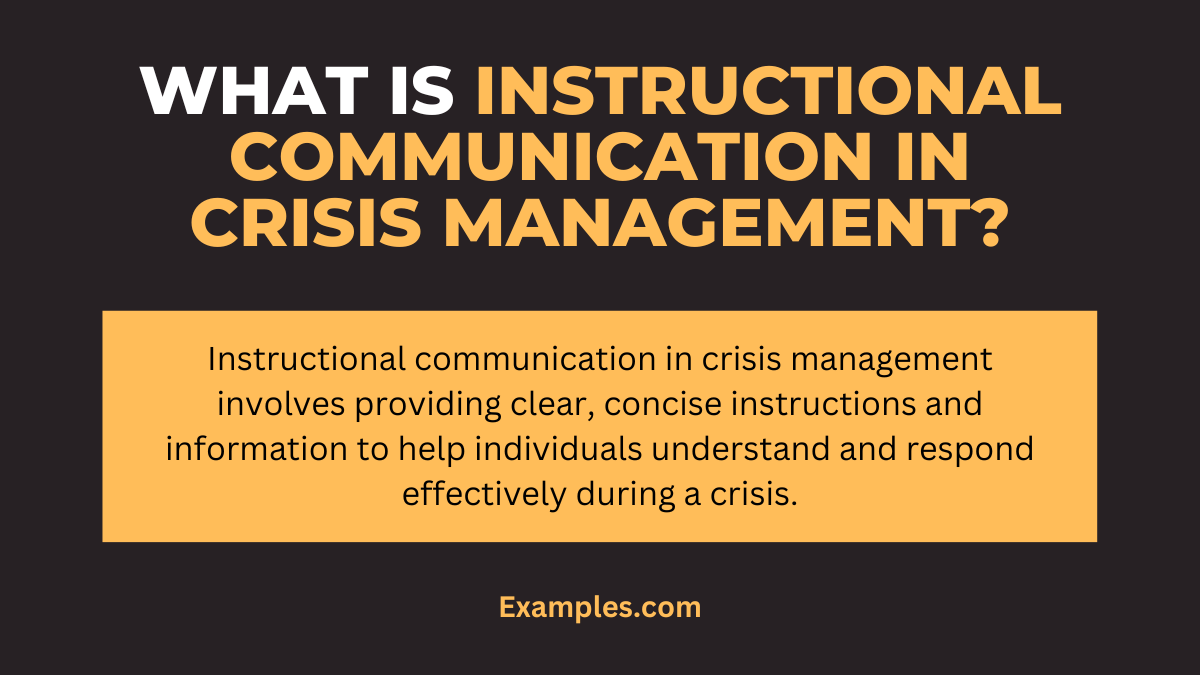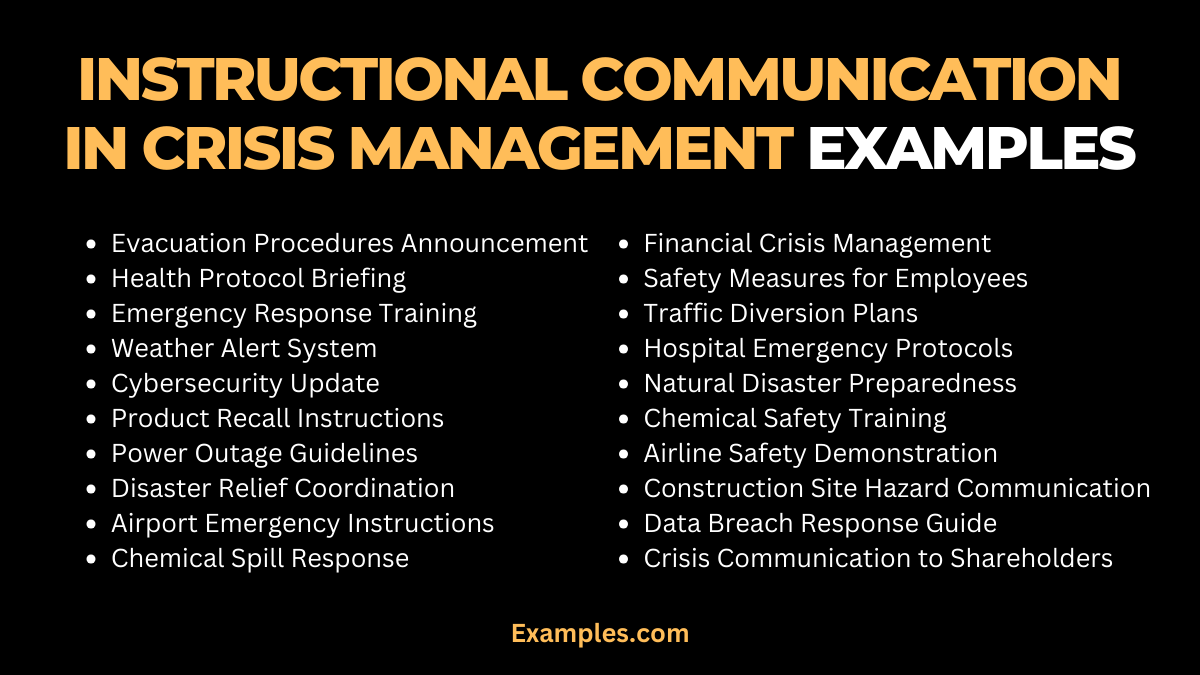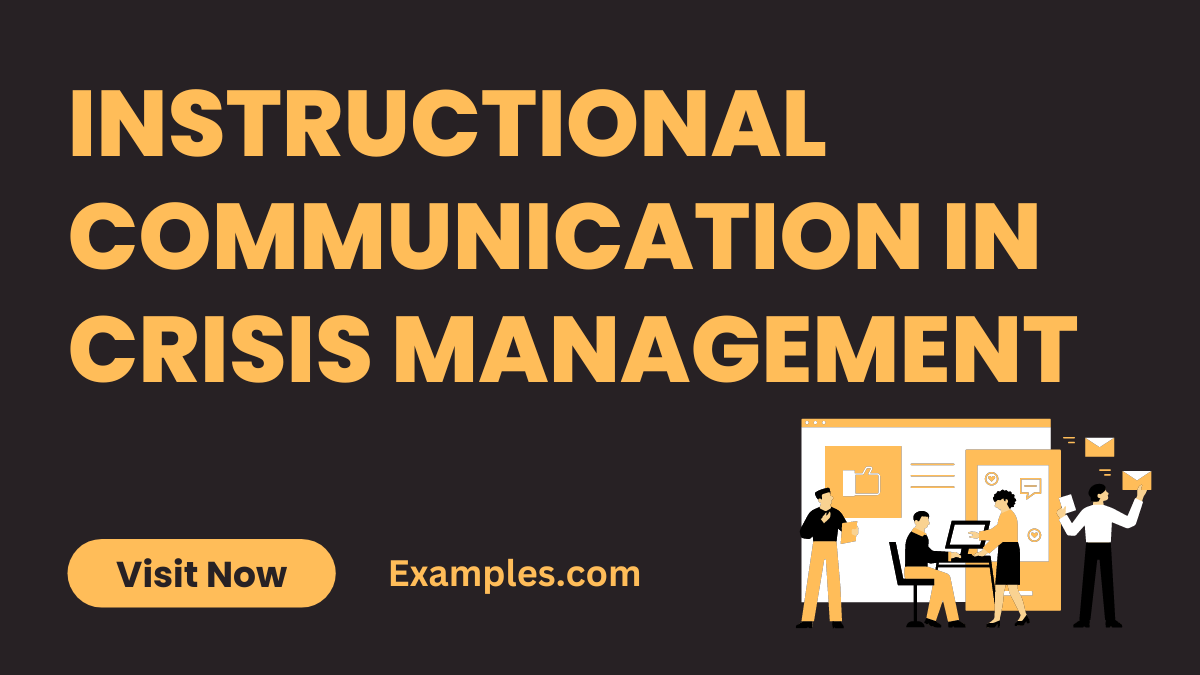Instructional Communication in Crisis Management
Instructional communication in crisis management plays a pivotal role in guiding individuals and organizations during emergencies. This guide provides an in-depth look at how clear, directive communication is essential in conveying safety procedures, emergency protocols, and response strategies. Featuring real-world communication examples, it explores the effective delivery of instructions to ensure safety and minimize confusion. Instructional communication not only informs but also reassures stakeholders, helping to maintain order and efficiency during crisis situations.
What is Instructional Communication in Crisis Management?

Instructional communication in crisis management involves providing clear, concise instructions and information to help individuals understand and respond effectively during a crisis. It focuses on guiding actions and behaviors to ensure safety and reduce confusion. This type of communication is crucial for helping people navigate through the crisis effectively, often including emergency procedures, safety guidelines, or steps to mitigate risks. It’s about delivering actionable, straightforward information to manage the situation and protect those involved.
20 Instructional Communication in Crisis Management Examples

Instructional communication plays a pivotal role in crisis management, providing clear and concise directions to effectively navigate and mitigate the impact of a crisis. It ensures that critical information is conveyed to stakeholders, enabling them to understand and respond appropriately to the situation. By prioritizing clarity and actionability, instructional communication becomes an essential tool in guiding individuals and organizations during times of crisis.
- Evacuation Procedures Announcement: A company issues an urgent but calm message instructing employees on evacuation procedures following a fire alarm. The message emphasizes safety routes and assembly points.
- Health Protocol Briefing: Amid a health crisis, a hospital sends detailed instructions to its staff about new health protocols, including PPE usage and patient handling procedures, to ensure everyone’s safety.
- Emergency Response Training: A school conducts a detailed emergency response training session, instructing teachers and students on how to act during situations like earthquakes or lockdowns.
- Weather Alert System: A local government uses a weather alert system to instruct residents about necessary precautions and steps to take during severe weather conditions.
- Cybersecurity Update: Following a cyber-attack, an IT department sends out an instructional communication to all employees about updated security protocols and password change procedures.
- Product Recall Instructions: A company issues a product recall, providing clear instructions to customers on how to return a defective product and obtain a replacement.
- Power Outage Guidelines: During an unexpected power outage, a utility company provides instructions to consumers on how to report outages and stay safe.
- Disaster Relief Coordination: A non-profit organization sends instructional communication to volunteers on how to effectively distribute aid in disaster-hit areas.
- Airport Emergency Instructions: Airport authorities broadcast clear, calm instructions to passengers and staff during an emergency evacuation scenario.
- Chemical Spill Response: In the event of a chemical spill, a factory’s management instructs employees on immediate containment and cleanup procedures.
- Financial Crisis Management: A financial institution instructs its employees on new operational strategies during an economic downturn.
- Pandemic Safety Measures for Employees: A corporate email detailing the step-by-step safety measures employees must follow to prevent the spread of a virus in the workplace.
- Traffic Diversion Plans: Local law enforcement issues instructions to the public about alternative routes during a major road closure.
- Hospital Emergency Protocols: During a medical emergency, hospital staff are guided through specific communication channels about critical patient care procedures.
- Natural Disaster Preparedness: A community receives instructions on how to prepare for an impending natural disaster, including securing homes and emergency kit preparation.
- Chemical Safety Training: Workers in a chemical plant receive detailed guidelines on handling hazardous materials safely.
- Airline Safety Demonstration: Flight attendants give precise instructions about safety protocols aboard an aircraft.
- Construction Site Hazard Communication: Construction workers are briefed about new safety measures to prevent accidents on site.
- Data Breach Response Guide: A technology company instructs its users on steps to secure their accounts after a data breach.
- Crisis Communication to Shareholders: A corporation sends a well-structured communication to its shareholders about handling a financial crisis and maintaining trust.
Examples of Instructional Communication in Crisis Management in Public Relations
Instructional communication in public relations during a crisis involves giving clear, actionable advice to stakeholders. This approach ensures people understand what steps to take or behaviors to adopt for safety or to mitigate the crisis’s impact.
- Creating a Crisis Response Handbook: Developing a comprehensive handbook with step-by-step instructions on handling various crisis scenarios, ensuring consistency in communication.
- Media Training Workshops: Conducting workshops for PR teams on how to effectively communicate during crises, emphasizing clarity and transparency.
- Emergency Hotlines: Establishing dedicated hotlines with clear instructions for the public to report incidents or seek assistance during emergencies.
- Online Crisis FAQs: Maintaining a crisis-specific FAQ page on the company website, addressing common concerns and providing clear guidance.
- Social Media Crisis Playbooks: Crafting playbooks with instructions on managing social media platforms during crises, including response templates and escalation procedures.
Examples of Instructional Communication in Crisis Management in Schools
In schools, instructional communication during a crisis is crucial for ensuring the safety and well-being of students and staff. It provides clear guidelines and procedures to follow during emergencies. Here are five examples:
- Emergency Drills: Conducting regular fire, earthquake, or lockdown drills with clear instructions to prepare students for various crisis situations.
- Parent-Teacher Communication Protocols: Establishing communication protocols to inform parents promptly during emergencies, specifying contact methods and expected updates.
- Online Learning Guidelines: Providing students with guidelines for online learning during crises, including instructions on accessing virtual classes and resources.
- Mental Health Resources: Offering instructions on accessing mental health support services for students and staff dealing with the emotional impact of a crisis.
- Crisis Communication Training: Training school staff on effective communication techniques during crises, emphasizing empathy and clarity in their instructions.
What are Instructional Communication Skills in Crisis Management?
Instructional communication skills in crisis management are vital competencies that involve conveying clear, concise, and actionable messages during emergencies. These skills include:
- Clarity and Conciseness: Deliver clear and straightforward instructions to avoid confusion. Conciseness ensures that the essential points are understood quickly.
- Effective Listening: Actively listen to concerns and queries, providing answers that address specific issues. This helps in tailoring the communication to meet the audience’s needs.
- Empathy and Reassurance: Show empathy to those affected by the crisis. Providing reassurance can help to alleviate anxiety and build trust.
- Adaptability: Be prepared to modify your messaging to suit different audiences and evolving situations. Adaptability ensures that your communication remains relevant and effective.
- Consistency: Maintain uniformity in your messages across all channels to avoid mixed messages. Consistent information helps in building credibility and reducing confusion.
- Authoritative Presence: Project confidence and authority to ensure that your instructions are taken seriously. An authoritative presence can command attention and encourage adherence to instructions.
- Calmness Under Pressure: Stay composed and articulate during high-stress situations. Calmness under pressure is crucial for clear thinking and effective communication.
What are Instructional Communication Techniques in Crisis Management?
Instructional communication techniques in crisis management involve specific methods to effectively guide and inform stakeholders during a crisis. These techniques include:
- Step-by-Step Guidelines: Offer detailed, sequential instructions for specific actions. This clarity can be crucial in emergencies where quick, decisive action is needed.
- Visual Aids: Employ diagrams, maps, or other visuals to supplement verbal instructions, enhancing understanding and retention.
- Scenario-Based Instructions: Use hypothetical situations to illustrate procedures, helping people visualize and prepare for potential crises.
- Active Feedback Loops: Encourage questions and feedback to ensure instructions are clear and understood. Addressing these questions can also help identify areas where further clarification is needed.
- Multi-Channel Delivery: Utilize various platforms, such as social media, email, or public announcements, to reach a wider audience and cater to different communication preferences.
- Real-Time Updates: Provide up-to-date information as the situation evolves, ensuring that instructions remain relevant and effective.
How to Manage Instructional Communication in Crisis Management?
- Prioritize Key Information: Focus on the most crucial instructions that need immediate attention. Ensure these instructions are easy to identify and understand.
- Use Multiple Channels: Utilize a variety of communication channels like social media, email, and public announcements to ensure widespread reach.
- Regular Updates: Keep stakeholders informed with consistent updates as new information becomes available or as the situation changes.
- Feedback Mechanism: Set up a system for receiving feedback from stakeholders to gauge the effectiveness of your communication and make necessary adjustments.
- Targeted Messaging: Customize your messages to address the specific needs and concerns of different groups within your audience.
- Training and Rehearsal: Regularly conduct training sessions and drills to ensure that your team is well-prepared to communicate effectively during a crisis.
Effective instructional communication is vital in crisis management. It involves clear, concise instructions, ensuring timely and accurate dissemination of critical information. This approach, emphasizing clarity and directness, helps stakeholders navigate crises efficiently, reducing confusion and enhancing safety. Emphasizing proactive measures and preparedness, instructional communication plays a key role in managing crisis situations effectively.



